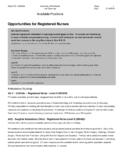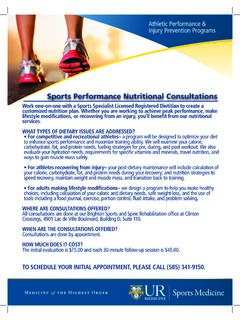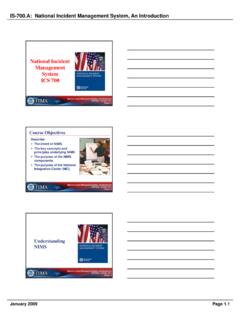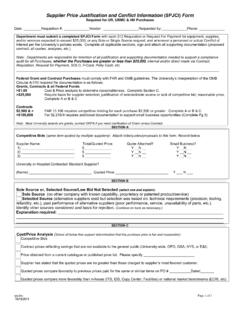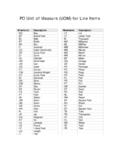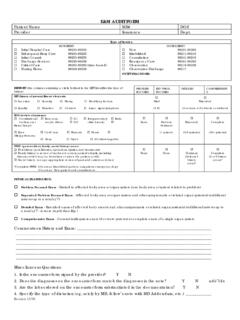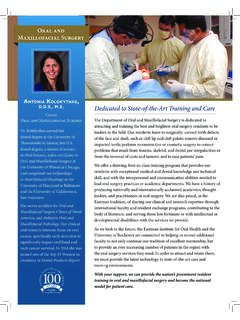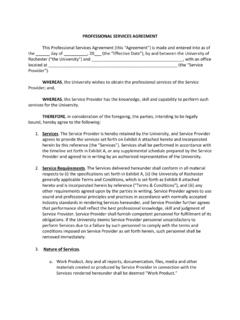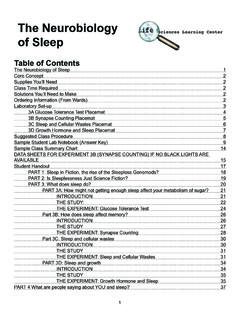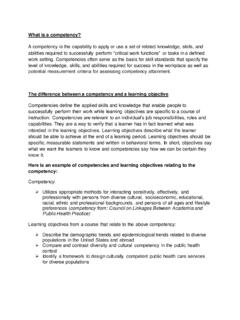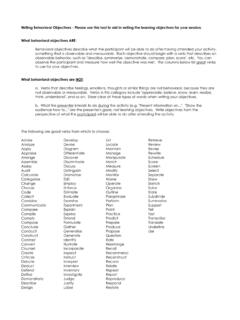Transcription of Behavioral Assessment and Intervention for Self-Injurious ...
1 Behavioral Assessment and Intervention for Self-Injurious BehaviorDavid McAdam, , BCBA-DRochester Regional Center for Autism Spectrum DisorderStrong Center for Developmental Disabilities2 RRCASD Webinar SeriesGet Started on Your Path to EmploymentKaitlyn Richardson, , March 14, 2018 3:00-4:00 at David B. McAdam, PhD, BCBA-DUniversity of Rochester School of MedicineDepartment of PediatricsStrong Center for Developmental Disabilities Warner School of Education and Human DevelopmentFebruary 2018 Rochester Regional Center for Autism Spectrum DisorderLearning objectives Increase understanding Understanding of challenging behavior and SIB Risks associated with SIB Why persons with developmental disabilities engage in SIB The Behavioral Assessment of SIB interventions for SIB that can be implemented by parents and service providers Understanding of situations which suggest that parents and professional without specific training require additional help Emerson ( 2005 ) defined challengingbehavior as.
2 Culturally abnormal behaviour of such intensity, frequency or duration that the physical safety of the person or others is placed in serious jeopardy, or behaviour which is likely to seriously limit or deny access to the use of ordinary community What is missing from this definition?Types of Challenging Behavior Displayed by Persons with ASD Self-Injurious behavior (SIB) Aggression Stereotypic Behavior Tantrums (non-compliance paired with negative vocalizations, and aggression) Property Destruction Feeding Problems (only eating a small number of foods) Pica RuminationDefinitions of Self-Injurious BehaviorSelf-injurious behavior (SIB), displayed by individuals with autism and intellectual disabilities, involves the occurrence of behavior that results in physical injury to one's own body (Kennedy Krieger Institute).SIB is defined as behaviors that result in physical injury to an individual s own body (Center for Autism Research; The Children s Hospital of Philadelphia).
3 Common forms of SIB Head Banging Punching oneself Hitting oneself Hand Arm Biting Picking skin or sores Pica (swallowing non-edible items or objects) Excessive skill rubbing or scratching RuminationCharacteristics of persons with intellectual disabilities who display SIB: Gender: Males=57% Female 43% Level of Mental Retardation: 71% with severe or profound mental retardation Negative relationship between and probability of displaying et al. (2002)Secondary Diagnoses Visual impairments (14%) Autism (10%) Hearing impairments (6%)Kahng et al. (2002)Topographies of Self-injury Head hitting Hair pulling Biting self Eye poking Hand mouthing Pinching self Body hitting Kicking Self ( , knee to head) Pica RuminationPotential Detrimental Consequences of SIB Interferes with learning ( , reduced rate of learning ) Increases monetary cost of serving a person in his or her lifetime.
4 Frequently results in placement in more restrictive settings Often result in referral to specialist (for example, a BCBA-D or licensed psychologist with specific training in Self-Injurious behavior)Causes/Theories of SIBWhy Do Individuals with Autism Engage in SIB?Biological Setting Events Pain due to: Otitis Media Headaches Gastroesophageal Reflux Disease or other GI problems Menstrual Pain Sleep Deprivation Mood Allergies (skin scratching)Environmental Setting Events Noise Crowded situations Certain people or activitiesMedical Causes Some individuals with ASD are hypothesized to engage in SIB as a way to relieve pain. By stimulating pain in a controlled way (through engaging in SIB), a person may seeks to mask another pain, such as an ear infection toothache, headache, or Predisposition Research studies have shown that some individuals genes may make them more likely to engage in SIB.
5 Genetic syndromes include: Lesch-Nyhan Prader-Willi Smith-Magenis Fragile X de LangeOperant Causes Social Positive Reinforcement Social Negative Reinforcement Non -social ReinforcementLet s look at each of these in some detailSocial Positive Reinforcement (positive reinforcement) Person with Autism engage in SIB in order to get attention from other people or access to a high preference item or activity Attention may be from parent, teacher, peer, or only during specific situations (for example, two people talk to each other but not to the person) To get a specific preferred item (for example, cookies, stuff animal, video game such as Mario Cart)Example of Positive ReinforcementJohn often hits himself in the head with his hand. Each time he hits himself he is reprimanded by his mother. John s frequency of SIB increases over time. Social Negative Reinforcement (negative reinforcement) SIB allows a person to escape from an activity (for example, math, brushing your teeth) SIB allows a person to avoid a situation that they find aversiveExample of Negative Reinforcement When asked to complete activities of daily living, such a brushing her teeth, Susan often bites herself on the hand.
6 Susan s teachers typically stop prompting her to complete the task. Susan s frequency of biting her hand increases over Reinforcement SIB is maintained by non-social factors SIB is not mediated by the actions of other people SIB should be as likelihood to occur when an individual is alone as in the presence of other peopleExample of Automatic ReinforcementJohn is alone in the front room of his group home. John is seated in a chair and occasionally hits himself in the head. Arousal TheoryIndividuals may engage in SIB to increase their arousal level or to counteract feeling over aroused. SIBs may be an attempt to release tension or relieve anxiety Note: Arousal theory has been very difficult to demonstrate convincingly and current level of supporting evidence is not Communication and SIB Many individuals with ASD have some form of communication difficulty.
7 SIB is seen most frequently in individuals with ASD who lack functional communication skills to express their wants and needs. The inability to communicate one s wants and needs sets the occasion for SIB. Discussion of the Assessment of SIBHow Often is SIB Socially Maintained versus Automatically Maintained? About 60% of SIB is socially maintained Approximately about 40% of SIB is non-socially maintainedWhy do we want to collect data? To be sure that the behavior in question is really a problem To be sure that the change in behavior really happened To make sure that all team members agree on the desired behavior change To serve as a source for functional assessmentFunctional ( Behavioral ) Assessment IDEA 1997 mandated that a functional Behavioral Assessment is part of any written behavior plan Overarching goal of functional Assessment is to determine why the behavior occurs Takes into account medical, genetic, and biological factors as well as environment Today s best practices in Assessment and Intervention of problem behavior includes an FBAWhy should we care about the function of a problem behavior?
8 When you know WHY a person is displaying SIB, you can better help a person decrease the behavior We usually try and find out why a person engages in SIB before we develop an interventionThree Types of Functional Assessments Questionnaires: Questions About Behavior Function (QABF) Motivational Assessment Scale (MAS) FAST (Functional Analysis Screening Tool) Direct observation: ABC Analysis Scatter Plot Experimental or Functional Analysis Questionnaires (MAS; QABF, FAST)Advantages: Easy to use and do not require much formal trainingDisadvantages: Often do not provide a clear answer. Might result in the development of a treatment that is less likely to be effectiveType of Questions Contained on Indirect Measures Engages in behavior to get attention (QABF) Engages in behavior when peer has something that he/she wants (QABF) Does the behavior seem to indicate to you that he/she is not feeling well?
9 (QABF) Does the behavior seem to occur in response to your talking to other persons in the room? (MAS) Does the behavior occur whenever you stop attending to the person (MAS) Does the behavior occur when you take away a favorite toy, food, or activity (MAS)MAS=6 point scale QABF=5 point scale Direct ObservationDirect observation in daily environment Focuses on observable antecedents and consequences of behavior; can also get information about time of day, duration, and frequency of problem behavior Can be done by outside observers for a specific interval of time Data can also be collected by parents, teachers, or staff throughout the dayConducting a Functional AnalysisDone when still don t know the function to the problem behaviorInvolves directly manipulating the antecedents and consequences for behaviorSometimes called an Experimental analysis or an Analog Functional AnalysisNeeds to be done by someone with experience in doing them (a BCBA or Behavior analyst)Typical Functional Analysis Conditions Negative Reinforcement (Demands) Positive Reinforcement (Tangible items or Social Attention) Automatic Reinforcement (Alone or Ignore)
10 Control or Toy Play SIB0123456123456789 10 11 12 13 14 15 16 17 18 19 20 21 22 23 24 25 26 27 28 29 30Se ssionNum ber per MinuteToy PlayTangibleAloneSocial At t ent ionDemandFunctional 10 11 12 13 14 15 16 17 18 19 20 SessionAggression Per MinuteToy PlaySocial AttentionTangibleDem andInterventions for SIBB ased on Behavioral FunctionDeveloping a HypothesisOnce a functional Assessment has been conducted, a hypothesis is developed regarding the function or purpose the behavior servesUse this hypothesis to develop an interventionCan intervene at many levels: Modify the setting event/establishing operation Modify the antecedent Change or add reinforcement to affect the consequence of behavior Provide the same of similar source of sensory (automatic) reinforcementAntecedent-based InterventionsAntecedent Environmental Manipulation-Altering aspects of an individual s surrounding that may serve as a discriminative stimulus (cue or signal for SIB) for SIB, that will in turn may modify the SIB in some AntecedentsModify antecedents for behavior by removing or modifying the things that set off behavior Eliminate specific tasks Go from easy to difficult tasks Embed tasks Change the prompts (the way you provide directives or instructions) Change the way that materials are presented Break down activity into discrete steps and (using task analysis)
